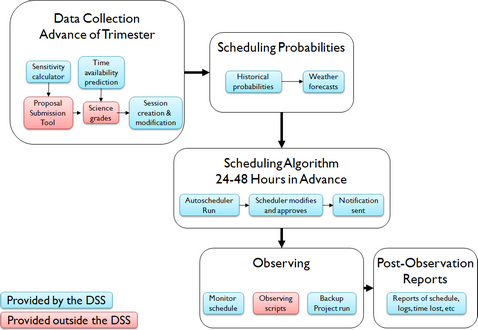Dynamic Scheduling System
Log-in to DSS
|
| ||
|---|---|---|---|
|
Introduction
The GBT spans a larger range of frequencies than other comparable centimeter/millimeter single-dish telescopes, and is located in a continental, mid-latitude region where weather is dominated by water vapor and small-scale effects. As a result, the observing efficiency of the GBT is enhanced significantly by the GBT's Dynamic Scheduling System (DSS), which allows observers to optimally match their desired weather conditions to their observations, resulting in considerably increased observing efficiency.
Unlike "standard" telescope dynamic scheduling systems, the GBT DSS is not queue based. That is, the GBT DSS schedules observers, not scripts. This fact is key to the overall underpinnings of the DSS which creates notifies observers 24-48 hours in advance of their observations.
At the start of a semester, at any any time during the semester, observers are required to indicate when they will not be available to observe on the GBT. Using this information, combined with the availability of the required hardware, the scientific priority of the projects, the predicted weather, and a number of other factors, the DSS will build a schedule every 24 hours for the period 24-48 hours from that time. Once the schedule is built, the relevant observers will be notified that their observations have been placed on the schedule. If the weather deteriorates after the schedule is built, the project observers can choose to give up their time to a backup project, or to observe in spite of the weather.
One of the components of the GBT DSS, which will both improve the ease of use of the GBT and make the DSS plans feasible, is the implementation of an observer's availability calendar for each project. With this calendar each observer can note the times he or she cannot be available for observing, blocking anything from an hour to months. The exciting part of this system is that any observer can update it at any time as that information will be immediately and automatically fed into the scheduling software. As a result, it is extremely easy for observers to make sure that GBT observing does not conflict with any other commitment.
There are, of course, many other details to the GBT DSS, such as the ability to schedule monitoring and fixed time observations, a ranking scheme for scheduling the projects, etc. All these details are publicly available through the DSS Memo series. An overview of the DSS process is given in the figure below.

Click on the image for a larger version
In addition to improving the observing efficiencies for high-frequency observers, the DSS will allow for more flexible use of the GBT. This will benefit both high and low-frequency observers in many ways, including:
- Pre-scheduled and elective projects (such as VLBI) have can have significantly more chances of successful observations
- Observations affected by transient RFI can be halted and seamlessly rescheduled;
- System faults (both in hardware and software) will be easier to work around and fixes will be easier to schedule, making the running of the GBT smoother and more efficient;
- Any "make-up time" needed for a project will be easily rescheduled, allowing the observations to be completed within the requested trimester;
- Rapid Response Proposals will be scheduled without disrupting another observer's scheduled time;
- Observers will be able to state when they wish to travel to Green Bank for observations, rather than being told by the telescope scheduler when to arrive;
- Observers will be able to change their availability for observing even as the trimester progresses rather than only a few months before a trimester begins
- Observers will be able to block out many small amounts of available time (e.g. when teaching classes) rather than needing to adjust their personal schedule to a pre-set telescope schedule;
- Observers will have the ability to observe a small part of their allotted time and then request a few days (or more) to analyze the data before using more telescope time;
- Complicated monitoring programs will be easily handled by the DSS;
- The GBT scheduling process will be transparent, allowing users to discern the likelihood of attaining telescope time as the trimester progresses.
More Information
- Main log-in for DSS
- GBT observer's Guide, with information on the DSS
- DSS Memo series.



